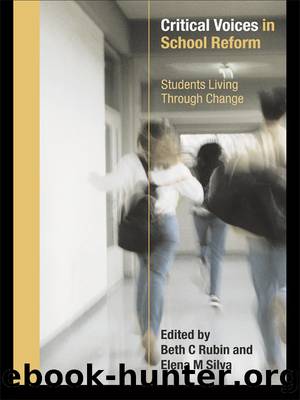Critical Voices in School Reform by Rubin Beth;Silva Elena;

Author:Rubin, Beth;Silva, Elena; [BETH C. RUBIN AND ELENA M. SILVA]
Language: eng
Format: epub
Publisher: Taylor & Francis Group
Published: 2011-09-01T00:00:00+00:00
Number seven and eight. Would someone like to come up and explain? [5 second pause] Number seven. [2 second pause] Thatâs how you get your points, guys. I give you your class grade based on your participation. Number seven? Someone give me the definition of slope again.3
Ramona answered the teacher and eventually went up to the overhead to do the problem. This was not the only time that participation points lured the grade-conscious but socially self-conscious students from their reticence. In fact, the students frequently volunteered on the condition of receiving these points, their hands shooting in the air with the cry, âParticipation points!â
In a conversation about assessment in her classroom, Marty told me that she gave students five participation points a day for things like presenting problems at the overhead. When I expressed awe at her meticulous bookkeeping, she confided that actually, she often just kind of guessed at the points. She told me, âThe kids think it counts more than it does.â As in many classrooms in which participation is linked to class grades, the teacher relied on her own professional judgment to assign a value to the quality of participation. Nonetheless, there was a deliberate gap between the official and unofficial meaning of participation points arising out of the practice of bluffing.
Bluffing suited the previously described influences on the participantsâ agendas. The teacherâs time constraint made it difficult to actually carry out the system she had set up, while the studentsâ minimized engagement â and their need to manage their images in front of their peers â precluded them from truly volunteering. The teacher thus used their perception of participation points to her advantage. When, in the above example, she sought a volunteer for problem seven, she relied on the lure of points to get the students to come forth. This strategy successfully addressed both the studentsâ and the teacherâs agendas: Marty could lure some of her reluctant students to engage with classroom activities, and the students could feel as if they were contributing to their grade in a socially acceptable way.
Download
This site does not store any files on its server. We only index and link to content provided by other sites. Please contact the content providers to delete copyright contents if any and email us, we'll remove relevant links or contents immediately.
The Art of Coaching Workbook by Elena Aguilar(50168)
Trainspotting by Irvine Welsh(21078)
Twilight of the Idols With the Antichrist and Ecce Homo by Friedrich Nietzsche(18324)
The Secret History by Donna Tartt(18269)
All the Missing Girls by Megan Miranda(14858)
Cat's cradle by Kurt Vonnegut(14804)
Ready Player One by Cline Ernest(14063)
Talking to Strangers by Malcolm Gladwell(12916)
Fangirl by Rainbow Rowell(8819)
The Compound Effect by Darren Hardy(8544)
Thirteen Reasons Why by Jay Asher(8493)
The remains of the day by Kazuo Ishiguro(8433)
Periodization Training for Sports by Tudor Bompa(7947)
Tools of Titans by Timothy Ferriss(7850)
Wonder by R. J. Palacio(7756)
The Lover by Duras Marguerite(7605)
Change Your Questions, Change Your Life by Marilee Adams(7405)
A Court of Wings and Ruin by Sarah J. Maas(7307)
The Complete Stick Figure Physics Tutorials by Allen Sarah(7162)
